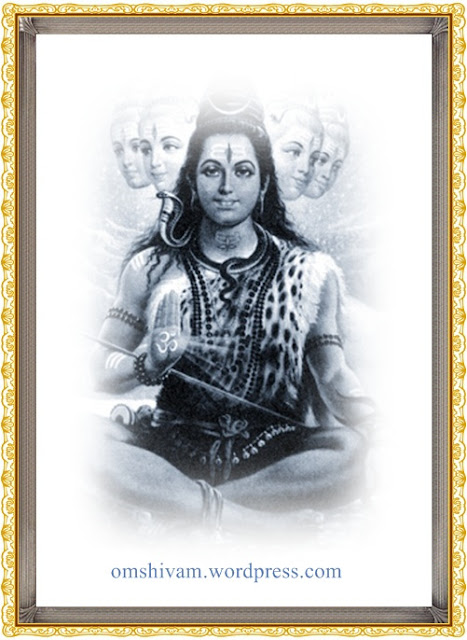
The Linga is the form of the absolute consciousness of the Universe - Shiva.The Linga denotes the form given to 'that which is beyond forms'.
Interestingly,Shiva is adored with 5 'faces' - denoting the 5 dimensions of the universe.
The 5 facets of Shiva finds reference in the 10th Chapter of Taittiriya Aranyaka ( the forest treaties of the Yajur Veda - The portions of the Vedas learnt originally in the forest region ).This portion is commonly referred to as 'Shiva Upasana Mantra'.
The Shivopasana Mantra is also part of the Mahanarayana Upanishad,one of the prominent Vaishnavite texts of Yajur Veda.
Video : Shivopasana mantra of Krishna Yajur Veda being recited by my students in Kriyalakshmi Shri Sai Gurukul,Setapak,Malaysia
In this portion, the procedure to consecrate ( energise with life force ) a Shiva Linga is described.22 sound combinations are used.
The consecrated Linga is then worshiped with verses that describe the 5 faces.
The 5 faces of Shiva :
Sadyojata,the western face
Vamadeva,the northern face
Aghora,the southern face
Tatpurushha,the eastern face
Ishana, the aspect facing the above direction
Each of these 5 faces tally with an element and aspect :
Sadyojata - Earth as element and Ego as aspect
Vamadeva - Water as element and Mind as aspect
Aghora - Fire as element and Intellect as aspect
Tatpurushha - Air as element and Nature ( prakriti ) as aspect
Ishana - Ether as element and Atma as aspect
Sadyojata represents the source of all existence.
Vamadeva represents the aspect which is beautiful and effulgent
Aghora represents the terrifying aspect of Shiva in tandem to the dissolution of Universe
Tatpurushha represents the supreme being
Ishana represents ruler
We attribute different dimensions of the cosmos to Shiva through these 5 facets.
SHaNmukha is said to be 6 headed because He is the combination of Shiva ( 5 faced ) and Shakti ( 1 faced ).
In Shaiva temples, the verses of Shivopasana mantra describing the 5 faces of Shiva are recited during Puja.
Video : Shivopasana mantra of Krishna Yajur Veda being recited by my students in Kriyalakshmi Shri Sai Gurukul,Setapak,Malaysia
In this portion, the procedure to consecrate ( energise with life force ) a Shiva Linga is described.22 sound combinations are used.
The consecrated Linga is then worshiped with verses that describe the 5 faces.
The 5 faces of Shiva :
Sadyojata,the western face
Vamadeva,the northern face
Aghora,the southern face
Tatpurushha,the eastern face
Ishana, the aspect facing the above direction
Each of these 5 faces tally with an element and aspect :
Sadyojata - Earth as element and Ego as aspect
Vamadeva - Water as element and Mind as aspect
Aghora - Fire as element and Intellect as aspect
Tatpurushha - Air as element and Nature ( prakriti ) as aspect
Ishana - Ether as element and Atma as aspect
Sadyojata represents the source of all existence.
Vamadeva represents the aspect which is beautiful and effulgent
Aghora represents the terrifying aspect of Shiva in tandem to the dissolution of Universe
Tatpurushha represents the supreme being
Ishana represents ruler
We attribute different dimensions of the cosmos to Shiva through these 5 facets.
SHaNmukha is said to be 6 headed because He is the combination of Shiva ( 5 faced ) and Shakti ( 1 faced ).
In Shaiva temples, the verses of Shivopasana mantra describing the 5 faces of Shiva are recited during Puja.
Shivopasana Mantra by my Whatsapp Veda Learner Robinson
Also Read :
(1) Shivopasana Mantra Meaning in English
Also Read :
(1) Shivopasana Mantra Meaning in English








Here is an elaborate description of these dive faces of Sadashiva, this is basis raja yoga (Pashupata marg) and it was self realized during my many subtle travels into that which is beyond what is usually considered as beyond
ReplyDeleteAghora face of Shiva (Aghora face of Shiva): https://www.makersmakings.org/aghora-face-of-sadashiva/
Tatpurusha face of Sadashiva (Tatpurusha face of Shiva): https://www.makersmakings.org/tatpurusha-face-of-sadashiva/
Vamadeva face of Sadashiva (Vamadeva face of Shiva): https://www.makersmakings.org/vamadeva-face-of-sadashiva-vaikunth/
Sadyojata face of Sadashiva (Sadyojata face of Shiva): https://www.makersmakings.org/sadyojata-face-of-sadashiva-brahmaloka/
Ishana face of Sadashiva (Ishana face of Shiva - Ishana itself is Pancha Mukha Sadashiva - Ishana is what Sadashiva means): https://www.makersmakings.org/pancha-mukha-sadashiva/
Panch Brahma Upanishad describes Sadashiva basis self-realization whilst based in Aghora, but above links are basis their actual states. Aghora is the last face of Sadashiva to get self-manifested, thus Aghora holds essences of other faces in it and what Pancha Brahma Upanishad describes is that which is self-realized whilst seeing those subtle essences of other faces but whilst still resting within Aghora face. Here is a link where this aspect is described as five faces of Brahma.
https://www.makersmakings.org/sadashiva-pradakshina-vedanta/
Love.